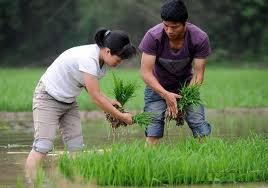Farmland Definition and question is What is a farmland?
Farmland is a block of land on which seeds can be planted and grown. Land specifically used for agricultural purposes in the raising of crops or livestock is called agricultural farmland. It is one of the main resources in agriculture.
Agricultural land is divided into 3 main components:
· Arable land: Block under which annual crops, such as cereals, potatoes, vegetables, and melons are grown.
· Permanent Crops: Fruit plantations such as Orchards and vineyards.
· Permanent Pastures: Areas for natural grasses and grazing of livestock, such as Meadows and pastures.
The first two components - arable land and land in permanent crops - constitute the cultivable land. The part of arable land actually under crops is called sown block or cropped block. The term farmland is ambiguous in the sense that it may refer, on the one hand, to agricultural land and, on the other hand, to cultivable or even only arable land.
Depending on the use of artificial irrigation, agricultural land is divided into irrigated and non-irrigated type. In arid and semi-arid countries agriculture is often confined to irrigated land, with very little farming possible in non-irrigated or rain fed areas.
Agricultural land constitutes only a part of any country's territory, which in addition also includes areas not suitable for agriculture, such as forests, mountains, and inland water bodies. Agricultural land covers 33% of the world's land area, with arable land representing less than one-third of agricultural land (9. 3% of the world's land area).
In geography and agriculture, arable land is land that can be used for growing crops. It includes all land under annual crops (double-cropped areas are counted only once), temporary meadows for mowing or market and kitchen gardens and land temporarily fallow (less than five years).
Block which is unsuitable for farming usually has at least one of the following deficiencies: no source of fresh water; too hot (desert); too cold (Arctic); too rocky; too mountainous; too salty; too rainy; too snowy; too polluted; or too nutrient poor. Clouds may block the sunlight hence reducing productivity plants need for photosynthesis. Starvation and nomads often exists on marginally cultivable land. Non-arable land is sometimes called wasteland, badlands, worthless or no man's land.
Farmland prices have been driven to an all-time high by good commodity prices and low interest rates, but there's an uncertainty about how long it will last. Due to nonstop deforestation even arable land has turns into wastelands. The price of farmland has rocketed sky high over the last two years, with growth rates similar to those seen in prime residential property in central London. Hence farmland prices remain uncertain.Farmland business time to time change.
Farmland is a block of land on which seeds can be planted and grown. Land specifically used for agricultural purposes in the raising of crops or livestock is called agricultural farmland. It is one of the main resources in agriculture.
Agricultural land is divided into 3 main components:
· Arable land: Block under which annual crops, such as cereals, potatoes, vegetables, and melons are grown.
· Permanent Crops: Fruit plantations such as Orchards and vineyards.
· Permanent Pastures: Areas for natural grasses and grazing of livestock, such as Meadows and pastures.
The first two components - arable land and land in permanent crops - constitute the cultivable land. The part of arable land actually under crops is called sown block or cropped block. The term farmland is ambiguous in the sense that it may refer, on the one hand, to agricultural land and, on the other hand, to cultivable or even only arable land.
Depending on the use of artificial irrigation, agricultural land is divided into irrigated and non-irrigated type. In arid and semi-arid countries agriculture is often confined to irrigated land, with very little farming possible in non-irrigated or rain fed areas.
Agricultural land constitutes only a part of any country's territory, which in addition also includes areas not suitable for agriculture, such as forests, mountains, and inland water bodies. Agricultural land covers 33% of the world's land area, with arable land representing less than one-third of agricultural land (9. 3% of the world's land area).
In geography and agriculture, arable land is land that can be used for growing crops. It includes all land under annual crops (double-cropped areas are counted only once), temporary meadows for mowing or market and kitchen gardens and land temporarily fallow (less than five years).
Block which is unsuitable for farming usually has at least one of the following deficiencies: no source of fresh water; too hot (desert); too cold (Arctic); too rocky; too mountainous; too salty; too rainy; too snowy; too polluted; or too nutrient poor. Clouds may block the sunlight hence reducing productivity plants need for photosynthesis. Starvation and nomads often exists on marginally cultivable land. Non-arable land is sometimes called wasteland, badlands, worthless or no man's land.
Farmland prices have been driven to an all-time high by good commodity prices and low interest rates, but there's an uncertainty about how long it will last. Due to nonstop deforestation even arable land has turns into wastelands. The price of farmland has rocketed sky high over the last two years, with growth rates similar to those seen in prime residential property in central London. Hence farmland prices remain uncertain.Farmland business time to time change.











